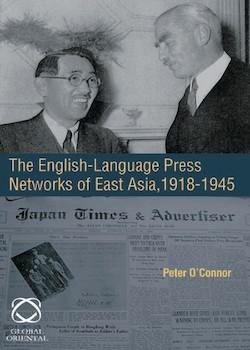The English-Language Press Networks of East Asia

By Peter O’Connor
Global Oriental
2010, 405 pages plus Xvi
ISBN 978-1-905246-67-0
Review by Ian Nish
“This book,” the author starts boldly, “argues that the English-language press of East Asia played a significant role in the shaping of international perceptions of Japan and East Asia (page 1).” Professor O’Connor justifies this claim with a wealth of detail gleaned from years of research in the field and from countless publications on the subject of Japanese government propaganda.
While newspapers in Japan were published from the middle of the 19th century onwards, the first major strides towards an organized industry were taken in 1891, just after the Meiji constitution had been ratified, with the founding of the Japan Chronicle in Kobe by Robert Young and the Japan Advertiser in Tokyo by a Scot named Meiklejohn. The global press in those days was not concentrated as today in the hands of large corporations but was small, local and diversified. So the English-language press of the East Asian treaty ports was not exceptional. It served the foreign mercantile communities and a fair number of Japanese in days when the Japanese-language press was slowly developing. But these were hard times for proprietors and idiosyncratic editors trying to survive in an uncertain market; and there were periodical crises when compromises had to be made. (The Japanese side of the story being complicated enough, we are excluding from this review the complexities of the Chinese and Korean press which O’Connor also covers.)
The main part of this study begins at the end of the first world war. O’Connor detects the emergence of three broad networks among English-language newspapers, magazines and news agencies. Firstly, Japan which was naturally anxious to present a favourable account of her actions to the world, had through the Information Bureau which the Foreign Ministry set up in 1904 begun to influence the press at home and through diplomatic channels abroad. Secondly, the Japan Chronicle group based in Kansai, capable and well-informed, had links with British media in Shanghai and Tianjin as also with Fleet Street. O’Connor describes this as “the British network” since it reflected views and prejudices of the British mercantile community, though not necessarily British government thinking. It was not uncommon for the British embassy in Tokyo to speak of the editors as “suffering from an exaggerated critical faculty.” Competing with the British-oriented media was, thirdly, the Japan Advertiser group which operated under the ownership of the American Wilfred Fleisher from 1908 till he sold it in 1940. His associates in China were often strongly anti-British but the Japan Advertiser under the editorship of the Scotsman Hugh Byas for three periods from 1914 until 1930 kept a neutral stance. These two groups tended to be critical (though not in unison) of the editorial line taken by the English-language outlets supported by “the Foreign Ministry network” which was becoming increasingly associated with the Japan Times. In the later 1930s the position of foreign newspapers became even more precarious because of shortage of revenues, government censorship and wartime conditions. The result was that the Chronicle accepted a subsidy from the Tokyo government in 1938 and the Advertiser sold out to the Japan Times in October 1940. The “Foreign Ministry network” proved to be the most durable of the three groups but was regarded with suspicion abroad, thus destroying its original objective of winning foreign support.
O’Connor’s interesting final chapter entitled “Publicity Warriors” deals with the way in which the Japan Times, now in charge of an amalgamated media, sets about reorienting the press in the conquered areas of Asia between 1941 and 1945. However hateful it was, English had, for practical reasons, to become the prime language of the armed occupation of the Asian continent and the Greater East Asian Co-prosperity Sphere.
This is a subtle story, full of twists, inconsistencies and contradictions. Generalization and interpretation are difficult. How significant was the expatriate press in an era of rising nationalism in Japan (and, of course, China)? It is probably fair to conclude that it had an effect much greater than its resources and circulation would suggest. In the 1930s these newspapers operated in the environment of a propaganda war and managed to have their say, even if it hardly affected policy-making in Japan or China. And yet elsewhere in the world where academics covering East Asia were few in number and foreigners with a knowledge of East Asian languages fewer still, these observation posts were heavily relied on. Foreign Ministry archives around the world now show that the views of these journalists were much read and had the effect of keeping diplomats on their toes. Moreover journalists from these papers like Morgan Young, Hugh Byas, Thomas Millard and Edgar Snow independently published many authoritative books on contemporary issues which carried great weight in “shaping international perceptions” of the area.
Professor O’Connor who has systematically analysed a vast amount of archival sources and has previously published a 40-volume series on related topics, has now distilled his findings in this compact volume. Students of the East Asian region will find this encyclopaedic work of reference an essential tool for their understanding. It is, however, a sad commentary on how a once free press can decline over time into one purveying government hand-outs!

